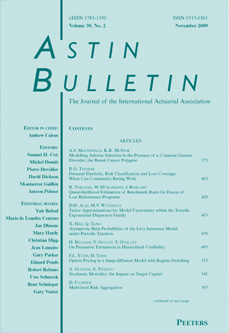next article in this issue  |

|
Document Details : Title: Linear Stochastic Reserving Methods Author(s): DAHMS, René Journal: ASTIN Bulletin Volume: 42 Issue: 1 Date: 2012 Pages: 1-34 DOI: 10.2143/AST.42.1.2160710 Abstract : In this article we want to motivate and analyse a wide family of reserving models, called linear stochastic reserving methods (LSRMs). The main idea behind them is the assumption that the (conditionally) expected changes of claim properties during a development period are proportional to exposures which depend linearly on the past. This means the discussion about the choice of reserving methods can be based on heuristic reasons about exposures driving the claims development, which in our opinion is much better than a pure philosophic approach. Moreover, the assumptions of LSRMs do not include the independence of accident periods. We will see that many common reserving methods, like the Chain-Ladder-Method, the Bornhuetter-Ferguson-Method and the Complementary-Loss-Ratio-Method, can be interpreted in this way. But using the LSRM framework you can do more. For instance you can couple different triangles via exposures. This leads to reserving methods which look at a whole bundle of triangles at once and use the information of all triangles in order to estimate the future development of each of them. We will present unbiased estimators for the expected ultimate and estimators for the mean squared error of prediction, which may become an integral part of IFRS 4. Moreover, we will look at the one period solvency reserving risk, which already is an important part of Solvency II, and present a corresponding estimator. Finally we will present two examples that illustrate some features of LSRMs. |
